Learn from the great: Well-written research article examples

Reading well-written research papers is not only enjoyable — it’s also (passive) learning that helps you write better papers yourself. But in most fields it’s quite rare to encounter a research article that is clear and easy to follow and truly a pleasure to read. So I am curating a list of handpicked papers from different disciplines, for when you want to read something nice as an inspiration for your own writing. This is an ongoing project: your suggestions of great papers are always welcome!
Reading and writing are tightly coupled processes that support each other.
Reading creates a basis for writing: it helps you passively build up your (scientific) vocabulary and “assimilate” the writing style and conventions. It’s a source that you can tap into as you write — it’s the input .
Writing , then, is the output . When you write you are combining words and phrases you know from reading into a new and unique mixture.
As my favorite quote by Pam Allyn says:
Reading is like breathing in; writing is like breathing out.

You write like what you read
After reading the book Writing Without Bullshit , my writing became direct, concise and to the point. When I was reading Writing With Power , my writing was clear and persuasive even though I was using more complex sentences just like the author was doing. And ever since I am regularly reading the (evidence-based) self-help blog of Mark Manson , my writing became lighter and more conversational. (I hope you appreciate it 😉 )
So if you want to write great research articles, the only thing you need to do is to read great research articles. That’s easy, right?
Well — theoretically. As you have surely noticed, truly well-written research papers are not so common. I think that’s partly because writing clearly about complex matters is inherently difficult — but partly also because the standards and expectations of scientific writing are set fairly low.
That’s why I decided to create this list of well-written scientific articles .
So far I have mostly included papers that I know from my own research work, papers labeled by students in my courses as being easy to read and papers suggested in the Facebook group Reviewer 2 Must Be Stopped and on the Writing Scientist Facebook page .
I have combed through over 100 suggested papers, yet only around 10% made it to the final selection. Apparently, what is easy to read for a specialist doesn’t necessarily reflect overall great writing quality…
Selection criteria
The list below includes selected research articles and other formats (reviews, opinion pieces) that are easy to read and understand also for non-specialists . Here is an overview of the selection criteria:
1. Text is easy to read and follow. This is achieved by:
- good paragraph structure ;
- good sentence structure ;
- reader’s guidance: motivating each next step, explaining relevant concepts, introducing abbreviations, creating connections between sentences and paragraphs;
- clear and precise language ;
- using jargon reasonably and simple language whenever possible.
2. Paper is well structured. Namely:
- Abstract provides a good overview of the article.
- Introduction motivates the research project and describes its context/background.
- Results section presents the results clearly and in a logical order.
- Discussion explains the importance of the results and places them in the context of previous research.
Articles that fail to satisfy several of these points are not included in this list.
For each included article, aspects that are particularly well done ( ) and those that are suboptimal ( ) are highlighted.
So, here we go:
Do you need to revise & polish your manuscript or thesis but don’t know where to begin?
Get your Revision Checklist
Click here for an efficient step-by-step revision of your scientific texts.
Biomedical sciences
Laventie BJ et al. (2019). A surface-induced asymmetric program promotes tissue colonization by Pseudomonas aeruginosa. Cell Host & Microbe , 25(1), 140-152.
Golding NL & Spruston N (1998). Dendritic sodium spikes are variable triggers of axonal action potentials in hippocampal CA1 pyramidal neurons. Neuron , 21(5), 1189-1200.
Reviews & other formats
Watnick P & Kolter R (2000). Biofilm, city of microbes. Journal of Bacteriology , 182(10), 2675-2679.
Lazebnik Y (2002). Can a biologist fix a radio?—Or, what I learned while studying apoptosis. Cancer Cell , 2(3), 179-182.
Natural sciences
Zimmerer J et al. (2019). Integrated extraction and catalytic upgrading of microalgae lipids in supercritical carbon dioxide. Green Chemistry , 21(9), 2428-2435.
Computer science & engineering
Brunton SL et al. (2016) Discovering governing equations from data by sparse identification of nonlinear dynamical systems. PNAS , 113(15), 3932-3937.
Gebauer NWA et al. (2019). Symmetry-adapted generation of 3d point sets for the targeted discovery of molecules. arXiv preprint arXiv :1906.00957.
Pal A et al. (2020). Optimal turbine blade design enabled by auxetic honeycomb. Smart Materials and Structures , 29(12), 125004.
Banko M & Bril E (2001). Scaling to very very large corpora for natural language disambiguation. In Proceedings of the 39th annual meeting of the Association for Computational Linguistics (pp. 26-33).
Rivest RL et al (1978). A method for obtaining digital signatures and public-key cryptosystems. Communications of the ACM , 21(2), 120-126.
Social sciences
Boyd R & Richerson PJ (1996). Why culture is common, but cultural evolution is rare. In Proceedings-British Academy Vol. 88, pp. 77-94. Oxford University Press Inc.
Kildal N (2003). Perspectives on Policy Transfer. The Case of the OECD. [working paper 13-2003]
Iyengar SS & Lepper MR (2000). When choice is demotivating: Can one desire too much of a good thing? Journal of Personality and Social Psychology , 79(6), 995.
Healy K (2017). Fuck nuance. Sociological Theory , 35(2), 118-127.
Do you know a well-written research article?
Are you disappointed because none of these articles is from your discipline? Or would you simply like to have more well-written research articles to pick from for your reading?
Then please, help grow this list by suggesting a freely accessible article that you found easy to read: [email protected] .
Stay updated
I hope to continuously extend this list and provide you with always new great articles to read. To enjoy and learn from.
Would you like to be notified about new additions ? Then join our weekly newsletter with tips and resources for your scientific writing.
Do you need to revise & polish your manuscript or thesis but don’t know where to begin? Is your text a mess and you don't know how to improve it?
Click here for an efficient step-by-step revision of your scientific texts. You will be guided through each step with concrete tips for execution.
10 thoughts on “ Learn from the great: Well-written research article examples ”
One which I think is easily accessible (even to a motivated high school student) is
“College Admissions and the Stability of Marriage” by Gale and Shapley.
It is very old though.
Thank you, I’ll check it out!
I like that one: Noorduin, Wim L., et al. “Rationally designed complex, hierarchical microarchitectures.” Science 340.6134 (2013): 832-837.
Thanks a lot!
Hi, Martina! If a shameless plug is allowed, maybe one of the following from our lab will work, too: https://doi.org/10.1017/S0261444820000580 – on applying social network analysis to peer networks of foreign language learners https://doi.org/10.1371/journal.pone.0081225 – on the interplay between emotions and social norms in bilingual swearing https://doi.org/10.24059/olj.v25i1.2492 – findings from a global study of teachers’ engagement in and coping with emergency remote instruction during the COVID-19 pandemic.
Hi Mike, thanks a lot! I’ll check them out.
Ahoj, Martino!
I wanted to suggest the paper “Spatial and Temporal Resolution in Cardiovascular MR Imaging: Review and Recommendations” by G. Slavin and D. Bluemke ( https://pubs.rsna.org/doi/abs/10.1148/radiol.2342031990?journalCode=radiology ). Some time ago, someone asked me about spatial and temporal resolution, and in that moment, I found this well-written paper which is one of my favourites in the topic. I hope you like it.
Thanks a lot, I will check it out!
I would also recommend imho excellent reading from physics: Observation of Gravitational Waves from a Binary Black Hole Merger: https://journals.aps.org/prl/abstract/10.1103/PhysRevLett.116.061102#fulltext I particularily like itroduction whcih can be accessible even to layperson outside this particular field.
Comments are closed.
Diese Webseite verwendet Cookies, um Ihnen ein besseres Nutzererlebnis zu bieten. Wenn Sie die Seite weiternutzen, stimmen Sie der Cookie-Nutzung zu.
25 Basic Research Examples

Chris Drew (PhD)
Dr. Chris Drew is the founder of the Helpful Professor. He holds a PhD in education and has published over 20 articles in scholarly journals. He is the former editor of the Journal of Learning Development in Higher Education. [Image Descriptor: Photo of Chris]
Learn about our Editorial Process

Basic research is research that focuses on expanding human knowledge, without obvious practical applications.
For a scholarly definition, we can turn to Grimsgaard (2023):
“Basic research, also called pure, theoretical or fundamental research, tends to focus more on ‘big picture’ topics, such as increasing the scientific knowledge base around a particular topic.”
It is contrasted with applied research , which “seeks to solve real world problems” (Lehmann, 2023).
Generally, basis research has no clear economic or market value, meaning it tends to take place in universities rather than private organizations. Nevertheless, this blue-skies basic research can lead to enormous technological breakthroughs that forms the foundation for future applied research .
Basic Research Examples
- Physics: Understanding the properties of neutrinos.
- Medicine: Investigating the role of gut microbiota in mental health.
- Anthropology: Studying the social structures of ancient civilizations.
- Biology: Exploring the mechanism of CRISPR-Cas9 gene editing.
- Psychology: Understanding the cognitive development in infants.
- Chemistry: Researching new catalytic processes for organic synthesis.
- Astronomy: Investigating the life cycle of stars.
- Sociology: Exploring the impacts of social media on society.
- Ecology: Studying the biodiversity in rainforests.
- Computer Science: Developing new algorithms for machine learning.
- Mathematics: Exploring new approaches to number theory.
- Economics: Investigating the causes and effects of inflation.
- Linguistics: Researching the evolution of languages over time.
- Political Science: Studying the effects of political campaigns on voter behavior.
- Geology: Investigating the formation of mountain ranges.
- Architecture: Studying ancient building techniques and materials.
- Education: Researching the impact of remote learning on academic performance.
- History: Investigating trade routes in the medieval period.
- Literature: Analyzing symbolism in 19th-century novels.
- Philosophy: Exploring concepts of justice in different cultures.
- Environmental Science: Studying the impact of plastics on marine life.
- Genetics: Investigating the role of specific genes in aging.
- Engineering: Researching materials for improving battery technology.
- Art History: Investigating the influence of politics on Renaissance art.
- Agricultural Science: Studying the impact of pest management practices on crop yield.
Case Studies
1. understanding the structure of the atom.
The study of atomic structure began in the early 1800s, with John Dalton’s atomic theory suggesting that atoms were indivisible and indestructible. However, it was not until the 20th century that Ernest Rutherford’s gold foil experiment led to the discovery of the nucleus and the proposal of the planetary model of the atom, which was further refined by Niels Bohr and eventually led to the quantum mechanical model, showing that electrons move in orbital shells around the nucleus.
Research Context:
- Topic: Investigating the structure and behavior of atoms.
- Purpose: Understand the fundamental particles (protons, neutrons, and electrons) and forces that govern atomic behavior.
- Methodology: Utilize particle accelerators, theoretical models, and experimental physics.
- Significance: Fundamental understanding of atomic structures has paved the way for numerous technological and scientific breakthroughs, such as the development of nuclear energy and advancements in chemistry and materials science.
Outcomes and Further Developments:
- Discovery and exploration of subatomic particles like quarks.
- Development of quantum mechanics and quantum field theory.
- Subsequent advancements in various scientific fields, such as nuclear physics, chemistry, and nanotechnology.
2. Researching the Human Genome
The Human Genome Project, an international research effort that began in 1990, aimed to sequence and map all of the genes – collectively known as the genome – of humans. Completed in 2003, it represented a monumental achievement in science, providing researchers with powerful tools to understand the genetic factors in human disease, paving the way for new strategies for diagnosis, treatment, and prevention.
- Topic: Investigating the structure, function, and mapping of the human genome.
- Purpose: Understand the genetic makeup of humans, identify genes, and learn how they work.
- Methodology: Techniques like DNA sequencing, genetic mapping, and computational biology.
- Significance: Foundational for various advancements in genetics, medicine, and biology, providing insights into diseases, development, and evolution.
- Completion of the Human Genome Project, which mapped the entire human genome.
- Advancements in personalized medicine, genetic testing, and gene therapy.
- Development of CRISPR technology, enabling precise genetic editing.
Basic Research vs Applied Research
Basic research focuses on expanding knowledge and understanding fundamental concepts without immediate practical application, while applied research focuses on solving specific, practical problems using the knowledge gained from basic research (Akcigit, Hanley & Serrano-Velarde, 2021).
A simple comparison of definitions is below:
- Basic research seeks to gain greater knowledge or understanding of the fundamental aspects of phenomena.
- Applied research seeks to solve practical problems the researcher or their stakeholders are facing.
A researcher might choose basic research over applied if their primary motivation is to expand the boundaries of human knowledge and contribute to academic theories, whilst they might favor applied research if they are more interested in achieving immediate solutions, innovations, or enhancements impacting real-world scenarios (Akcigit, Hanley & Serrano-Velarde, 2021; Baetu, 2016).
To learn more about applied research, check out my article on applied research.
Basic Research: Disappearing in 21st Century Universities?
In the 1980s, universities increasingly came under pressure to prove their specific financial value to society. This has only intensified over the decades. So, whereas once universities were preoccupied with basic research, there’s been a big push toward academic-industry collaborations where research demonstrates its economic value, rather than its cultural or intellectual value, to society. This may, on the one hand, help make universities relevant to today’s world. But on the other hand, it may interfere with the blue skies research that could identify and solve the bigger, less financially pressing, questions and problems of our ages (Bentley, Gulbrandsen & Kyvik, 2015).
Pros and Cons of Basic Research
The primary advantage of basic research is that it generates knowledge and understanding of fundamental principles that can later serve as a foundation for technological advancement or social betterment.
It can lead to groundbreaking discoveries, stimulate creativity, and drive scientific innovation by satisfying human curiosity (Akcigit, Hanley & Serrano-Velarde, 2021; Baetu, 2016).
It is also often the catalyst for training the next generation of scientists and researchers.
However, basic research can be time-consuming, expensive, and its outcomes may not always be directly observable or immediately beneficial.
This is why it’s often left to government-funded research institutes and universities to conduct this sort of research. As Binswanger (2014) argues, “basic research constitutes, for the most part, a common good which cannot be sold profitably on markets.
Furthermore, its value is often underestimated because the applications are not immediately apparent or tangible.
Below is a summary of some advantages and disadvantages of basic research:
Abeysekera, A. (2019). Basic research and applied research. Journal of the National Science Foundation of Sri Lanka , 47 (3).
Akcigit, U., Hanley, D., & Serrano-Velarde, N. (2021). Back to basics: Basic research spillovers, innovation policy, and growth. The Review of Economic Studies , 88 (1), 1-43.
Baetu, T. M. (2016). The ‘big picture’: the problem of extrapolation in basic research. The British Journal for the Philosophy of Science.
Bentley, P. J., Gulbrandsen, M., & Kyvik, S. (2015). The relationship between basic and applied research in universities. Higher Education , 70 , 689-709. ( Source )
Binswanger, M. (2014). How nonsense became excellence: forcing professors to publish. In Welpe, I. M., Wollersheim, J., Osterloh, M., & Ringelhan, S. (Eds.), Incentives and Performance: Governance of Research Organizations . Springer International Publishing.
Grimsgaard, W. (2023). Design and strategy: a step by step guide . New York: Taylor & Francis.
Lehmann, W. (2023). Social Media Theory and Communications Practice . London: Taylor & Francis.
Wiid, J., & Diggines, C. (2009). Marketing Research . Juta.

- Chris Drew (PhD) https://helpfulprofessor.com/author/chris-drew-phd/ Free Social Skills Worksheets
- Chris Drew (PhD) https://helpfulprofessor.com/author/chris-drew-phd/ 10 Reasons you’re Perpetually Single
- Chris Drew (PhD) https://helpfulprofessor.com/author/chris-drew-phd/ 20 Montessori Toddler Bedrooms (Design Inspiration)
- Chris Drew (PhD) https://helpfulprofessor.com/author/chris-drew-phd/ 21 Montessori Homeschool Setups
Leave a Comment Cancel Reply
Your email address will not be published. Required fields are marked *
- Privacy Policy

Home » Research Paper – Structure, Examples and Writing Guide
Research Paper – Structure, Examples and Writing Guide
Table of Contents
A research paper is a detailed academic document that presents the results of a study or investigation. It involves critical analysis, evidence-based arguments, and a thorough exploration of a specific topic. Writing a research paper requires following a structured format to ensure clarity, coherence, and academic rigor. This article explains the structure of a research paper, provides examples, and offers a practical writing guide.

Research Paper
A research paper is a formal document that reports on original research or synthesizes existing knowledge on a specific topic. It aims to explore a research question, present findings, and contribute to the broader field of study.
For example, a research paper in environmental science may investigate the effects of urbanization on local biodiversity, presenting data and interpretations supported by credible sources.
Importance of Research Papers
- Knowledge Contribution: Adds to the academic or professional understanding of a subject.
- Skill Development: Enhances critical thinking, analytical, and writing skills.
- Evidence-Based Arguments: Encourages the use of reliable sources to support claims.
- Professional Recognition: Serves as a medium for sharing findings with peers and stakeholders.
Structure of a Research Paper
1. title page.
The title page includes the paper’s title, author’s name(s), affiliation(s), and submission date.
- Title: “The Impact of Remote Work on Employee Productivity During the COVID-19 Pandemic”
- Author: Jane Doe
- Affiliation: XYZ University
2. Abstract
A concise summary of the research, typically 150–300 words, covering the purpose, methods, results, and conclusions.
- Example: “This study examines the effects of remote work on employee productivity. Data collected from surveys and interviews revealed that productivity increased for 65% of respondents, primarily due to flexible schedules and reduced commuting times.”
3. Introduction
The introduction sets the context for the research, explains its significance, and presents the research question or hypothesis.
- Background information.
- Problem statement.
- Objectives and research questions.
- Example: “With the rapid shift to remote work during the pandemic, understanding its impact on productivity has become crucial. This study aims to explore the benefits and challenges of remote work in various industries.”
4. Literature Review
The literature review summarizes and critiques existing research, identifying gaps that the current study addresses.
- Overview of relevant studies.
- Theoretical frameworks.
- Research gaps.
- Example: “Previous studies highlight improved flexibility in remote work but lack comprehensive insights into its impact on team collaboration and long-term productivity.”
5. Methodology
This section explains how the research was conducted, ensuring transparency and replicability.
- Research design (qualitative, quantitative, or mixed methods).
- Data collection methods (surveys, interviews, experiments).
- Data analysis techniques.
- Ethical considerations.
- Example: “A mixed-methods approach was adopted, using online surveys to collect quantitative data from 200 employees and semi-structured interviews with 20 managers to gather qualitative insights.”
The results section presents the findings of the research in an objective manner, often using tables, graphs, or charts.
- Example: “Survey results indicated that 70% of employees reported higher job satisfaction, while 40% experienced challenges with communication.”
7. Discussion
This section interprets the results, relates them to the research questions, and compares them with findings from previous studies.
- Analysis and interpretation.
- Implications of the findings.
- Limitations of the study.
- Example: “The findings suggest that while remote work enhances individual productivity, it poses challenges for team-based tasks, highlighting the need for improved communication tools.”
8. Conclusion
The conclusion summarizes the key findings, emphasizes their significance, and suggests future research directions.
- Example: “This study demonstrates that remote work can enhance productivity, but organizations must address communication barriers to maximize its benefits. Future research should focus on sector-specific impacts of remote work.”
9. References
A list of all the sources cited in the paper, formatted according to the required style (e.g., APA, MLA, Chicago).
- Creswell, J. W. (2018). Research Design: Qualitative, Quantitative, and Mixed Methods Approaches . Sage Publications.
10. Appendices
Supplementary materials, such as raw data, survey questionnaires, or additional analyses, are included here.
Examples of Research Papers
1. education.
Title: “The Effectiveness of Interactive Learning Tools in Enhancing Student Engagement”
- Abstract: Summarizes findings that interactive tools like Kahoot and Quizlet improved engagement by 45% in middle school classrooms.
- Methods: Quantitative surveys with 300 students and qualitative interviews with 15 teachers.
2. Healthcare
Title: “Telemedicine in Rural Healthcare: Opportunities and Challenges”
- Abstract: Highlights how telemedicine improved access to healthcare for 80% of surveyed rural residents, despite connectivity issues.
- Methods: Mixed methods involving patient surveys and interviews with healthcare providers.
3. Business
Title: “The Role of Artificial Intelligence in Enhancing Customer Experience”
- Abstract: Discusses how AI tools like chatbots reduced response times by 30%, improving customer satisfaction in the e-commerce sector.
- Methods: Case studies of three leading e-commerce companies and customer feedback analysis.
Writing Guide for a Research Paper
Step 1: choose a topic.
Select a topic that aligns with your interests, is relevant to your field, and has sufficient scope for research.
Step 2: Conduct Preliminary Research
Review existing literature to understand the context and identify research gaps.
Step 3: Develop a Thesis Statement
Formulate a clear and concise statement summarizing the main argument or purpose of your research.
Step 4: Create an Outline
Organize your ideas and structure your paper into sections, ensuring a logical flow.
Step 5: Write the First Draft
Focus on content rather than perfection. Start with the sections you find easiest to write.
Step 6: Edit and Revise
Review for clarity, coherence, grammar, and adherence to formatting guidelines. Seek feedback from peers or mentors.
Step 7: Format and Finalize
Ensure your paper complies with the required citation style and formatting rules.
Tips for Writing an Effective Research Paper
- Be Clear and Concise: Avoid jargon and lengthy explanations; focus on delivering clear arguments.
- Use Credible Sources: Rely on peer-reviewed articles, books, and authoritative data.
- Follow a Logical Structure: Maintain a coherent flow from introduction to conclusion.
- Use Visual Aids: Include tables, charts, and graphs to summarize data effectively.
- Cite Sources Properly: Avoid plagiarism by adhering to proper citation standards.
Common Pitfalls to Avoid
- Lack of Focus: A vague or overly broad topic can weaken the paper’s impact.
- Poor Organization: A disorganized structure makes the paper hard to follow.
- Inadequate Analysis: Merely presenting data without interpreting its significance undermines the paper’s value.
- Ignoring Guidelines: Failing to meet formatting or citation requirements can detract from professionalism.
A research paper is a critical academic tool that requires careful planning, organization, and execution. By following a clear structure that includes essential components like the introduction, methodology, results, and discussion, researchers can effectively communicate their findings. Understanding the elements and employing best practices ensures a well-crafted and impactful research paper that contributes meaningfully to the field.
- Babbie, E. (2020). The Practice of Social Research . Cengage Learning.
- Bryman, A. (2016). Social Research Methods . Oxford University Press.
- Booth, W. C., Colomb, G. G., & Williams, J. M. (2016). The Craft of Research . University of Chicago Press.
- APA (2020). Publication Manual of the American Psychological Association (7th ed.). American Psychological Association.
About the author
Muhammad Hassan
Researcher, Academic Writer, Web developer
You may also like

Problem Statement – Writing Guide, Examples and...

Table of Contents – Types, Formats, Examples

Research Paper Title Page – Example and Making...

Research Results Section – Writing Guide and...

Data Collection – Methods Types and Examples

Research Objectives – Types, Examples and...

Article Summary
Ai generator.
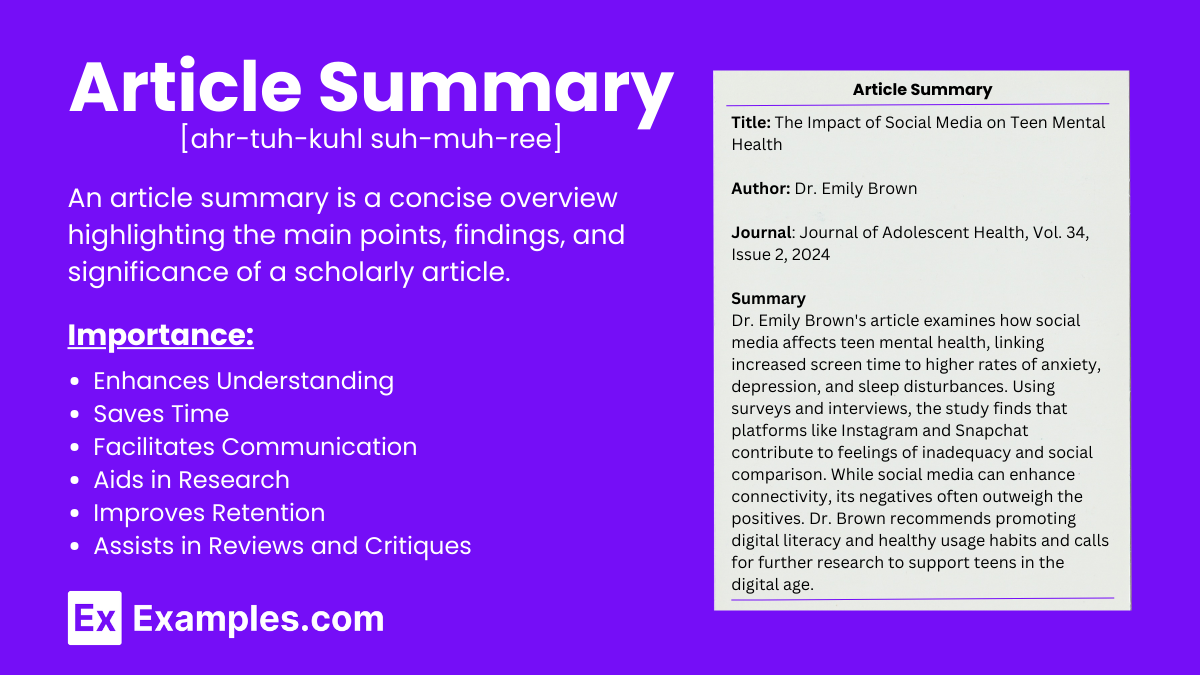
In the vast realm of academia and journalism, effective communication is key. Whether you’re navigating through a scientific journal, medical literature, or a newspaper article , the ability to condense complex information into a concise and coherent summary is an invaluable skill . In this article, we will delve into the art of crafting article summaries, exploring various genres such as journal articles, medical literature, and newspaper reports . From understanding the fundamentals to exploring practical examples, this guide aims to equip you with the tools necessary to unlock the power of summarization and enhance your competitive advantage in the world of written communication.
What is an Article Summary?
An article summary is a brief, concise version of a larger text that highlights the main points and essential details. It aims to provide readers with a quick overview of the content, saving time and enhancing comprehension. An effective summary captures key information without personal opinions, maintaining the original text’s integrity and intent.
Article Summary Format
[Title of the Article]
[Author(s) Name(s)]
[Name of the Journal, Volume, Issue, Pages, Year]
Introduction
Objective : Summarize the primary aim or objective of the article. Context : Provide a brief background or context for the study or topic.
Summary of Key Points
- Key Point 1 : Summarize the first main point or finding of the article.
- Key Point 2 : Summarize the second main point or finding of the article.
- [Additional points as necessary]
Methodology
Approach : Describe the research methods or approach used in the study. Data Collection : Summarize how the data was collected (e.g., surveys, experiments, observations). Analysis : Provide an overview of the data analysis techniques used.
Findings : Highlight the key results or findings of the study. Implications : Discuss the implications of these findings.
Summary : Recap the main conclusions of the article. Future Research : Mention any suggestions for future research or unanswered questions.
Critique (Optional)
Strengths : Discuss the strengths of the article. Weaknesses : Mention any weaknesses or limitations of the article. Overall Evaluation : Provide a brief overall evaluation or impression of the article.
References (Optional)
Citations : List any references or additional readings cited in the summary.
Title The Effects of Social Media on Academic Performance Author(s) John Doe, Jane Smith Source Journal of Educational Psychology, Volume 45, Issue 2, Pages 123-134, 2020 Introduction Objective : To investigate the impact of social media usage on the academic performance of college students. Context : With the rise of social media, understanding its effects on various aspects of life, including education, has become crucial. Summary of Key Points Usage Patterns : The article identifies common social media usage patterns among students. Positive Effects : Highlights how social media can facilitate learning and collaboration. Negative Effects : Discusses the potential distractions and time management issues caused by social media. Methodology Approach : Mixed-methods approach combining quantitative surveys and qualitative interviews. Data Collection : Data was collected from 500 college students through online surveys and follow-up interviews with 50 students. Analysis : Statistical analysis was used for the survey data, while thematic analysis was conducted on the interview transcripts. Results Findings : The study found a significant correlation between high social media usage and lower academic performance. However, moderate use for educational purposes showed positive effects. Implications : These findings suggest that while excessive social media use can be detrimental, it can also be a valuable educational tool if used appropriately. Conclusion Summary : The article concludes that social media has both positive and negative impacts on academic performance, depending on usage patterns. Future Research : Recommends further research on the long-term effects of social media usage and strategies to integrate it effectively into educational settings. Critique (Optional) Strengths : Comprehensive data collection and balanced analysis of both positive and negative effects. Weaknesses : Limited to self-reported data, which may introduce bias. Overall Evaluation : The article provides valuable insights but could benefit from longitudinal studies to better understand long-term impacts. References (Optional) Citations : Doe, J., & Smith, J. (2020). The effects of social media on academic performance. Journal of Educational Psychology, 45(2), 123-134.
Article Summary Examples
Examples of article summary for students.
Title: The Benefits of Reading Every Day Author: John Doe Publication Date: May 10, 2023 Main Idea: Reading daily improves cognitive function, reduces stress, and enhances empathy. Key Points:
- Introduction: The article introduces the importance of incorporating reading into daily routines.
- Body: It outlines cognitive benefits such as improved focus and memory, emotional benefits like stress reduction, and social benefits including increased empathy and understanding of others.
- Conclusion: The article concludes by encouraging readers to make reading a regular habit for overall well-being. Significance: This article is valuable for students as it highlights the broad benefits of reading, encouraging lifelong learning and personal development.
Title: The Effects of Sleep on Academic Performance Author: Dr. Emily Carter Publication Date: March 15, 2024 Main Idea: Adequate sleep significantly enhances students’ academic performance by improving memory, concentration, and problem-solving skills. Key Points:
- Introduction: The article begins by emphasizing the importance of sleep for students.
- Body: It discusses how sleep affects brain function, including memory consolidation and cognitive performance, supported by scientific studies.
- Conclusion: The article concludes with practical tips for students to improve their sleep habits for better academic outcomes. Significance: This article is crucial for students aiming to optimize their academic performance by understanding and prioritizing proper sleep.
Title: The Role of Technology in Modern Education Author: Sarah Lee Publication Date: February 1, 2023 Main Idea: Technology has transformed education by enhancing accessibility, engagement, and personalized learning. Key Points:
- Introduction: The article introduces the growing role of technology in education.
- Body: It explores various technological tools like online learning platforms, interactive software, and digital resources that support diverse learning styles and needs.
- Conclusion: The article concludes by highlighting the potential of technology to continue shaping the future of education positively. Significance: This article is important for students and educators as it provides insights into the benefits and potential of integrating technology in educational settings.
Title: The Impact of Nutrition on Learning Author: Dr. Laura Williams Publication Date: January 8, 2024 Main Idea: Proper nutrition is essential for optimal brain function and academic success. Key Points:
- Introduction: The article introduces the connection between diet and cognitive performance.
- Body: It details how balanced diets with essential nutrients support concentration, memory, and overall brain health, backed by research.
- Conclusion: The article concludes with recommendations for healthy eating habits to enhance learning. Significance: This article is vital for students and parents, emphasizing the role of nutrition in achieving academic goals.
Title: The Importance of Time Management for Students Author: Michael Adams Publication Date: April 12, 2024 Main Idea: Effective time management skills are crucial for academic success and stress reduction. Key Points:
- Introduction: The article begins by discussing the challenges students face in managing their time.
- Body: It provides strategies for prioritizing tasks, setting goals, and avoiding procrastination, supported by practical examples.
- Conclusion: The article concludes by encouraging students to develop time management skills to balance academics and personal life. Significance: This article is essential for students looking to improve their productivity and academic performance through better time management.
Examples of Article Summary for Research
Title: Advances in Renewable Energy Technologies Author: Dr. Maria Gonzalez Publication Date: September 12, 2023 Main Idea: The article explores recent innovations in renewable energy technologies and their potential to combat climate change. Key Points:
- Introduction: The article introduces the urgent need for renewable energy solutions in the face of global warming.
- Body: It covers advancements in solar, wind, and bioenergy technologies, highlighting breakthroughs in efficiency and cost reduction.
- Conclusion: The article concludes with an optimistic outlook on the future adoption of these technologies worldwide. Significance: This article is crucial for researchers and policymakers focused on sustainable energy solutions and climate change mitigation.
Title: The Impact of Artificial Intelligence on Healthcare Author: Dr. James Lee Publication Date: November 20, 2023 Main Idea: Artificial intelligence (AI) is revolutionizing healthcare by improving diagnostics, personalized medicine, and operational efficiency. Key Points:
- Introduction: The article introduces the role of AI in modern healthcare systems.
- Body: It discusses AI applications in medical imaging, predictive analytics, and patient care, supported by case studies and recent research findings.
- Conclusion: The article concludes with challenges and ethical considerations in the widespread adoption of AI in healthcare. Significance: This article is significant for healthcare professionals, researchers, and tech developers interested in the integration of AI in medical practices.
Title: The Effects of Microplastics on Marine Life Author: Dr. Linda Robinson Publication Date: January 5, 2024 Main Idea: The article examines how microplastics affect marine ecosystems, focusing on ingestion, bioaccumulation, and ecosystem health. Key Points:
- Introduction: The article begins by explaining what microplastics are and their prevalence in the marine environment.
- Body: It explores the impact of microplastics on various marine species, including physical harm and chemical toxicity, backed by empirical studies.
- Conclusion: The article concludes with potential solutions and policy recommendations to mitigate microplastic pollution. Significance: This article is essential for environmental researchers, policymakers, and conservationists working to protect marine ecosystems.
Title: Trends in Global Migration Patterns Author: Dr. Michael Thompson Publication Date: July 18, 2023 Main Idea: The article analyzes recent trends in global migration, considering economic, social, and political factors. Key Points:
- Introduction: The article introduces the complexity and scale of modern migration movements.
- Body: It examines push and pull factors influencing migration, regional migration trends, and the impact on both origin and destination countries.
- Conclusion: The article concludes with policy implications and future projections for global migration. Significance: This article is important for researchers, sociologists, and policymakers studying human migration and its effects on global development.
Title: The Role of CRISPR in Genetic Engineering Author: Dr. Emily Clark Publication Date: March 3, 2024 Main Idea: CRISPR technology is advancing genetic engineering by allowing precise and efficient gene editing. Key Points:
- Introduction: The article introduces CRISPR and its revolutionary impact on genetic research.
- Body: It details applications of CRISPR in medicine, agriculture, and biological research, highlighting recent successful experiments and studies.
- Conclusion: The article concludes with ethical considerations and future potential of CRISPR technology. Significance: This article is critical for genetic researchers, biotechnologists, and ethicists interested in the future of genetic engineering and its societal implications.
Short Article Summary Examples
- Introduction: Highlights the urgent need for renewable energy solutions.
- Body: Discusses advancements in solar, wind, and bioenergy technologies.
- Conclusion: Optimistic outlook on global adoption of these technologies. Significance: Crucial for researchers and policymakers focused on sustainable energy.
Title: The Impact of Artificial Intelligence on Healthcare Author: Dr. James Lee Publication Date: November 20, 2023 Main Idea: AI is revolutionizing healthcare by improving diagnostics, personalized medicine, and efficiency. Key Points:
- Introduction: Introduces AI’s role in healthcare.
- Body: Covers AI applications in imaging, analytics, and patient care.
- Conclusion: Discusses challenges and ethical considerations. Significance: Important for healthcare professionals and tech developers.
Title: The Effects of Microplastics on Marine Life Author: Dr. Linda Robinson Publication Date: January 5, 2024 Main Idea: Examines the impact of microplastics on marine ecosystems. Key Points:
- Introduction: Explains microplastics and their prevalence.
- Body: Discusses harm to marine species and ecosystem health.
- Conclusion: Recommends solutions and policy changes. Significance: Essential for environmental researchers and policymakers.
Title: Trends in Global Migration Patterns Author: Dr. Michael Thompson Publication Date: July 18, 2023 Main Idea: Analyzes recent trends in global migration. Key Points:
- Introduction: Introduces complexity of migration movements.
- Body: Examines factors influencing migration and regional trends.
- Conclusion: Provides policy implications and future projections. Significance: Important for researchers and policymakers studying migration.
Title: The Role of CRISPR in Genetic Engineering Author: Dr. Emily Clark Publication Date: March 3, 2024 Main Idea: CRISPR technology advances genetic engineering by enabling precise gene editing. Key Points:
- Introduction: Introduces CRISPR’s impact on genetic research.
- Body: Details applications in medicine, agriculture, and research.
- Conclusion: Discusses ethical considerations and future potential. Significance: Critical for genetic researchers and ethicists.

News Article Summary Examples
Title: Global Leaders Pledge Climate Action at Summit Author: Jane Parker Publication Date: June 10, 2024 Main Idea: World leaders committed to significant climate action measures at the recent global summit. Key Points:
- Introduction: The summit focused on urgent climate change solutions.
- Body: Leaders from 50 countries pledged to reduce carbon emissions and invest in renewable energy.
- Conclusion: The summit concluded with a consensus on immediate action plans. Significance: This article highlights global efforts to combat climate change and the collective commitment of world leaders.
Title: Breakthrough in Alzheimer’s Research Announced Author: Dr. Samuel Davis Publication Date: June 5, 2024 Main Idea: Scientists have made a significant breakthrough in Alzheimer’s research, potentially leading to new treatments. Key Points:
- Introduction: The article introduces the promising new study.
- Body: Researchers discovered a method to slow disease progression using a novel drug.
- Conclusion: Clinical trials are set to begin later this year. Significance: This article is crucial for medical professionals and families affected by Alzheimer’s, offering hope for future treatments.
Title: New Education Reform Bill Passed Author: Rachel Kim Publication Date: June 8, 2024 Main Idea: A new education reform bill aiming to improve public school systems has been passed by the government. Key Points:
- Introduction: The bill addresses key issues in education.
- Body: It includes measures for increased funding, teacher support, and updated curricula.
- Conclusion: The bill received bipartisan support and will be implemented next school year. Significance: This article is important for educators, students, and parents, outlining upcoming changes in the education system.
Title: Major Earthquake Strikes Coastal City Author: John Miller Publication Date: June 9, 2024 Main Idea: A major earthquake struck a coastal city, causing significant damage and casualties. Key Points:
- Introduction: The earthquake measured 7.8 on the Richter scale.
- Body: It caused widespread destruction, with emergency services working to rescue survivors.
- Conclusion: Recovery efforts are underway, with international aid arriving. Significance: This article provides vital information for those affected and highlights the need for disaster preparedness.
Title: Tech Giant Unveils Latest Smartphone Author: Laura Johnson Publication Date: June 11, 2024 Main Idea: A leading tech company has unveiled its latest smartphone model, featuring groundbreaking technology. Key Points:
- Introduction: The new smartphone was revealed at a highly anticipated event.
- Body: It boasts advanced features such as enhanced AI, improved battery life, and a revolutionary camera system.
- Conclusion: The smartphone will be available for purchase next month. Significance: This article is relevant for tech enthusiasts and consumers looking for the latest innovations in mobile technology.
Examples of Article Summary in APA Style
Title: Advances in Renewable Energy Technologies Author: Dr. Maria Gonzalez Publication Date: September 12, 2023 Summary: Gonzalez, M. (2023, September 12). Advances in renewable energy technologies. Journal of Sustainable Energy . This article explores recent innovations in renewable energy technologies and their potential to combat climate change. It highlights advancements in solar, wind, and bioenergy technologies, focusing on efficiency and cost reduction. The article concludes with an optimistic outlook on global adoption of these technologies.
Title: The Impact of Artificial Intelligence on Healthcare Author: Dr. James Lee Publication Date: November 20, 2023 Summary: Lee, J. (2023, November 20). The impact of artificial intelligence on healthcare. Healthcare Innovation Journal . This article examines how AI is revolutionizing healthcare by improving diagnostics, personalized medicine, and operational efficiency. It discusses AI applications in medical imaging, predictive analytics, and patient care, and addresses challenges and ethical considerations.
Title: The Effects of Microplastics on Marine Life Author: Dr. Linda Robinson Publication Date: January 5, 2024 Summary: Robinson, L. (2024, January 5). The effects of microplastics on marine life. Marine Ecology Journal . This article investigates the impact of microplastics on marine ecosystems, including ingestion, bioaccumulation, and ecosystem health. It explains the prevalence of microplastics and their harmful effects on various marine species, and recommends solutions and policy changes to mitigate pollution.
Title: Trends in Global Migration Patterns Author: Dr. Michael Thompson Publication Date: July 18, 2023 Summary: Thompson, M. (2023, July 18). Trends in global migration patterns. International Migration Review . This article analyzes recent trends in global migration, considering economic, social, and political factors. It examines push and pull factors, regional migration trends, and the impact on both origin and destination countries, concluding with policy implications and future projections.
Title: The Role of CRISPR in Genetic Engineering Author: Dr. Emily Clark Publication Date: March 3, 2024 Summary: Clark, E. (2024, March 3). The role of CRISPR in genetic engineering. Genetic Research Journal . This article discusses how CRISPR technology is advancing genetic engineering by allowing precise and efficient gene editing. It details applications of CRISPR in medicine, agriculture, and biological research, and addresses ethical considerations and future potential.
Examples of Article Summary in MLA Style
Title: Advances in Renewable Energy Technologies Author: Dr. Maria Gonzalez Publication Date: September 12, 2023 Summary: Gonzalez, Maria. “Advances in Renewable Energy Technologies.” Journal of Sustainable Energy , 12 Sept. 2023. This article explores recent innovations in renewable energy technologies and their potential to combat climate change. It highlights advancements in solar, wind, and bioenergy technologies, focusing on efficiency and cost reduction. The article concludes with an optimistic outlook on global adoption of these technologies.
Title: The Impact of Artificial Intelligence on Healthcare Author: Dr. James Lee Publication Date: November 20, 2023 Summary: Lee, James. “The Impact of Artificial Intelligence on Healthcare.” Healthcare Innovation Journal , 20 Nov. 2023. This article examines how AI is revolutionizing healthcare by improving diagnostics, personalized medicine, and operational efficiency. It discusses AI applications in medical imaging, predictive analytics, and patient care, and addresses challenges and ethical considerations.
Title: The Effects of Microplastics on Marine Life Author: Dr. Linda Robinson Publication Date: January 5, 2024 Summary: Robinson, Linda. “The Effects of Microplastics on Marine Life.” Marine Ecology Journal , 5 Jan. 2024. This article investigates the impact of microplastics on marine ecosystems, including ingestion, bioaccumulation, and ecosystem health. It explains the prevalence of microplastics and their harmful effects on various marine species, and recommends solutions and policy changes to mitigate pollution.
Title: Trends in Global Migration Patterns Author: Dr. Michael Thompson Publication Date: July 18, 2023 Summary: Thompson, Michael. “Trends in Global Migration Patterns.” International Migration Review , 18 July 2023. This article analyzes recent trends in global migration, considering economic, social, and political factors. It examines push and pull factors, regional migration trends, and the impact on both origin and destination countries, concluding with policy implications and future projections
Title: The Role of CRISPR in Genetic Engineering Author: Dr. Emily Clark Publication Date: March 3, 2024 Summary: Clark, Emily. “The Role of CRISPR in Genetic Engineering.” Genetic Research Journal , 3 Mar. 2024. This article discusses how CRISPR technology is advancing genetic engineering by allowing precise and efficient gene editing. It details applications of CRISPR in medicine, agriculture, and biological research, and addresses ethical considerations and future potential.
More Article Summary Examples & Samples in PDF
1. journal article summary.
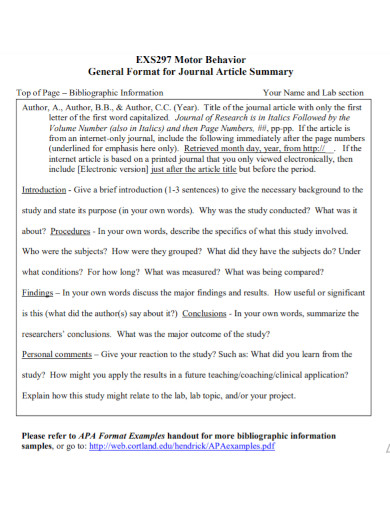
2. Math-Science Article Summary
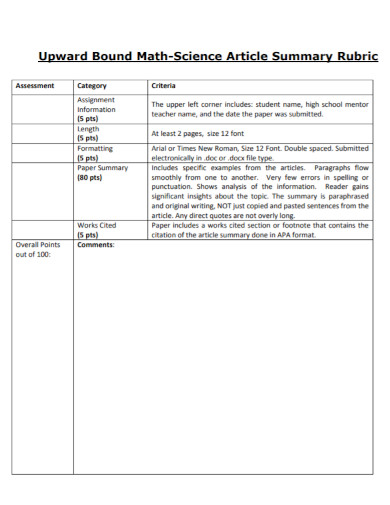
3. Article Summary Template
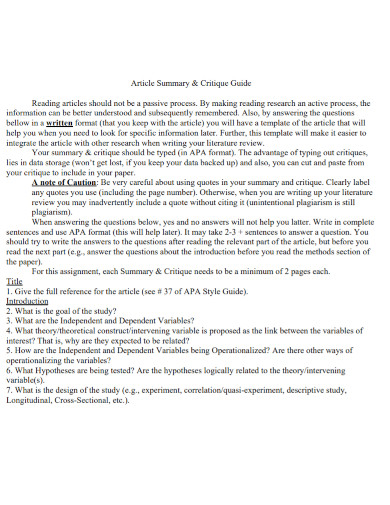
4. Journal Article Summary Example
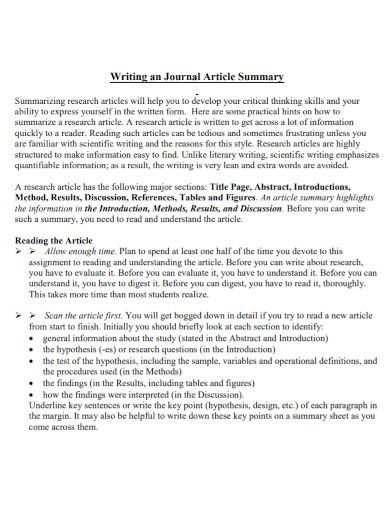
5. Newspaper Article Summary
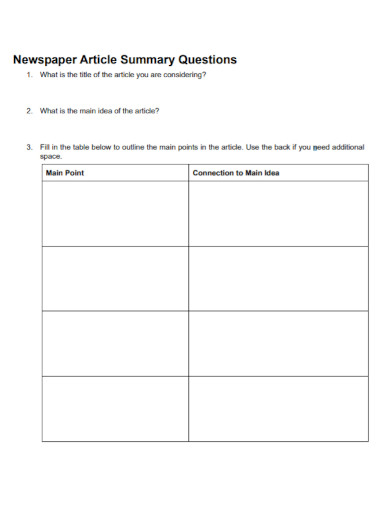
6. Extra Credit Article Summary
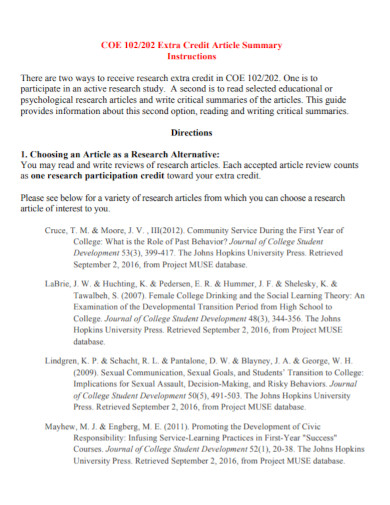
7. Article Summary Active Learning
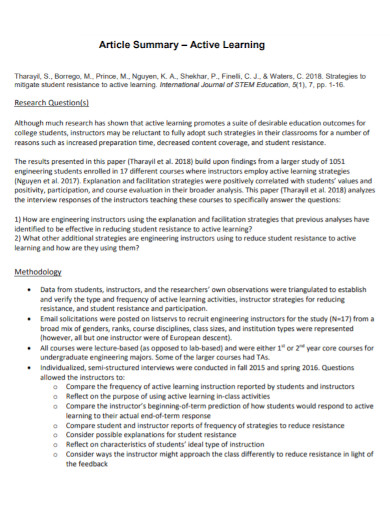
8. Child Rights Article Summary
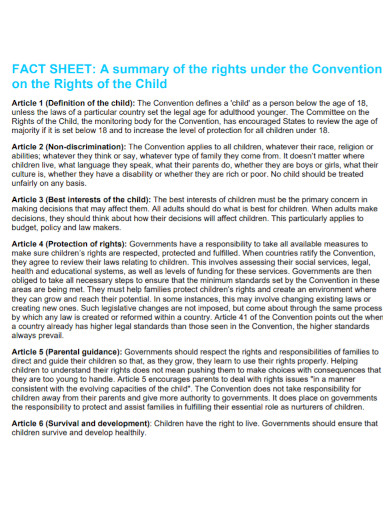
9. Medical Article Summary
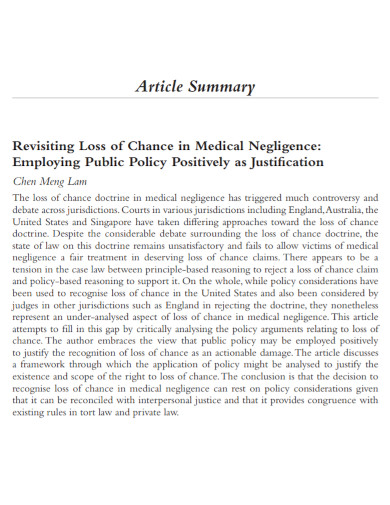
Steps to Summarize an Article Effectively
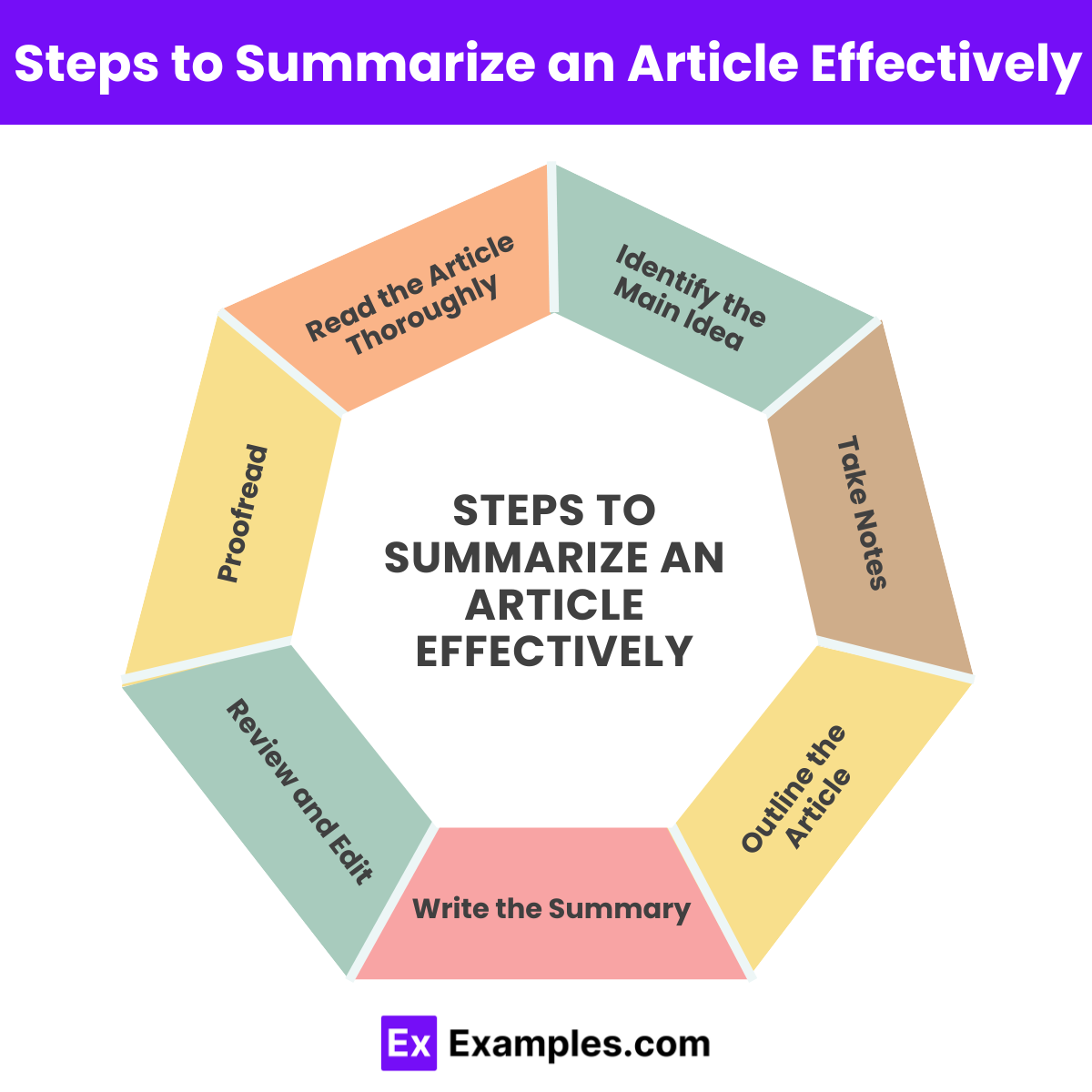
Summarizing an article requires understanding its key points and condensing them into a concise form. Here are the steps to effectively summarize an article:
1. Read the Article Thoroughly
- First Reading: Read the article in its entirety to understand the main ideas and arguments.
- Second Reading: Read it again to identify and underline key points, main arguments, and important details.
2. Identify the Main Idea
- Thesis Statement: Find the thesis statement or the main idea of the article.
- Main Points: Identify the supporting arguments or points that explain the thesis.
3. Take Notes
- Key Details: Jot down essential details that support the main points.
- Quotations: Note any important quotes that encapsulate key ideas.
4. Outline the Article
- Introduction: Summarize the introduction, including the thesis statement.
- Body Paragraphs: Write a brief summary of each section or paragraph.
- Conclusion: Summarize the conclusion and any final thoughts or recommendations.
5. Write the Summary
- First Draft: Write a first draft of your summary using your notes and outline.
- Conciseness: Be concise and focus on the main points, avoiding unnecessary details.
- Own Words: Use your own words to avoid plagiarism.
6. Review and Edit
- Accuracy: Check that your summary accurately reflects the article’s main points.
- Clarity: Ensure the summary is clear and easy to understand.
- Brevity: Make sure your summary is brief, usually about one-third of the original article length.
7. Proofread
- Grammar and Spelling: Correct any grammatical or spelling errors.
- Flow and Coherence: Ensure the summary flows logically and is coherent.
What to Include in a Summary of an Article?
A well-crafted summary captures the essence of the original article in a condensed form. Here’s what you should include:
1. Title and Author
- Title: Mention the title of the article.
- Author: Include the name of the author.
2. Main Idea or Thesis Statement
- Thesis Statement: Clearly state the main idea or thesis of the article.
- Purpose: Explain the purpose of the article, whether it is to inform, argue, entertain, or persuade.
3. Key Points
- Supporting Arguments: Highlight the key points and supporting arguments that explain the thesis.
- Evidence: Include major pieces of evidence or examples that support these key points.
4. Important Details
- Critical Information: Add any critical information necessary to understand the main points.
- Noteworthy Quotes: Include significant quotes that encapsulate key ideas (if relevant).
5. Conclusion
- Summary of Conclusion: Briefly summarize the conclusion of the article.
- Final Thoughts: Mention any final thoughts, recommendations, or implications provided by the author.
Common mistakes to avoid in Article Summarization
1. including too much detail.
- Overly Detailed: Avoid adding too many specific details, examples, or anecdotes from the original article.
- Lengthy Summaries: Keep your summary concise, focusing only on the main points.
2. Omitting Key Points
- Missing Main Ideas: Ensure you include all the key points and main arguments.
- Incomplete Picture: Avoid leaving out critical information that is necessary for understanding the article’s main idea.
3. Using the Same Words as the Article
- Plagiarism: Refrain from copying sentences or phrases directly from the article.
- Lack of Paraphrasing: Use your own words to explain the main ideas and key points.
4. Adding Personal Opinions
- Subjective Views: Do not include your own opinions, interpretations, or analysis in the summary.
- Bias: Maintain an objective tone, reflecting the original author’s intent and perspective.
5. Misinterpreting the Main Idea
- Inaccurate Summary: Make sure you correctly understand the article’s thesis and main arguments before summarizing.
- Confusion: Avoid confusing the reader by misrepresenting the article’s core message.
6. Neglecting the Article’s Structure
- Ignoring Organization: Follow the structure of the original article, summarizing each section systematically.
- Disorganized Summary: Ensure your summary is organized and flows logically.
7. Failing to Mention the Title and Author
- Lack of Attribution: Always include the title of the article and the author’s name to provide proper context.
- Context Omission: This helps the reader understand the source and context of the summary.
8. Overlooking the Conclusion
- Incomplete Summary: Don’t forget to summarize the conclusion and any final thoughts of the article.
- Missing Closure: Ensure the summary reflects the article’s ending to provide a complete overview.
How to Write an Article Summary
Writing an article summary involves condensing the main ideas of a longer text into a shorter, concise version. This skill is essential for students, educators, and professionals who need to understand and communicate key points quickly. Follow these steps to write an effective article summary:
- Initial Reading : Read the article from start to finish without taking notes. This helps you understand the overall message and tone.
- Second Reading : Read the article again, this time highlighting key points, main arguments, and significant details.
2. Identify the Main Ideas
- Thesis Statement : Locate the thesis statement or the main argument of the article. This is usually found in the introduction.
- Supporting Points : Identify the primary supporting points that the author uses to back up the thesis. These are typically found in the body paragraphs.
- Conclusion : Note any conclusions or final thoughts the author presents.
- Create an outline of the main ideas and supporting details. Use bullet points for clarity.
- Write down any significant quotes or data that are crucial to the article’s argument.
4. Write the Summary
- Introduction : Start with an introductory sentence that includes the article’s title, author, and the main point.
- Body Paragraphs : Summarize each main idea in a separate paragraph. Combine supporting points to create a concise version of the article.
- Conclusion : End with a concluding sentence that reflects the author’s final thoughts or conclusions.
5. Revise and Edit
- Check for Clarity : Ensure your summary clearly conveys the main ideas without adding your interpretations.
- Eliminate Redundancies : Remove any repetitive or unnecessary information.
- Grammar and Style : Proofread for grammatical errors and ensure the summary is written in a consistent style.
How long should an article summary be?
An article summary should be concise, typically one-third of the original article length, focusing on the main points and key arguments without unnecessary details.
What is the main purpose of summarizing an article?
The main purpose is to condense the article’s key points and main ideas, providing a clear and concise understanding of the content without reading the entire text.
How can I ensure my summary is accurate?
Ensure accuracy by thoroughly reading the article multiple times, taking notes on key points, and comparing your summary with the original to check for completeness and correctness.
Should I include quotes in my summary?
Include quotes only if they encapsulate a key idea or argument succinctly. Otherwise, paraphrase the information in your own words to maintain brevity.
Can I add my own opinion in the summary?
No, a summary should be objective and free from personal opinions. It should only reflect the author’s ideas and arguments presented in the article.
How do I handle complex information in a summary?
Simplify complex information by breaking it down into key points and summarizing them clearly. Avoid technical jargon unless it’s essential to the main ideas.
Is it necessary to follow the article’s structure in my summary?
Yes, follow the article’s structure to maintain logical flow and coherence. Summarize each section or paragraph systematically to ensure all main points are covered.
How do I summarize an article if it has multiple authors?
Mention all authors at the beginning of the summary. For example, “The article by Jane Doe, John Smith, and Emily Johnson discusses…”
What should I do if the article has no clear thesis?
Identify the main theme or overall message of the article. Focus on summarizing the central ideas and key points that support this theme.
How can I improve my summarization skills?
Practice regularly by summarizing various articles, seeking feedback, and refining your ability to identify key points and convey them concisely and accurately.
Text prompt
- Instructive
- Professional
10 Examples of Public speaking
20 Examples of Gas lighting
PSY 201 Child Development: Examples of Articles
- Reference Sources
- Finding Books and Videos
- Finding Articles
- Examples of Articles
- APA 6th This link opens in a new window
- APA 7th This link opens in a new window
Literature Review
Primary Research articles are nearly always presented in academic journals. They report on the process and results of primary research. They contain sections on: literature review, methods and materials, results and conclusions. Sometimes the sections have slightly different names. Primary articles tend to be more complex than other types of literature, but the abstract can help give you a general understanding of what will follow in the article.
Below is an example of a journal article. (click on image for full article)

You can tell it is a journal article because you can see the title of the journal, the volume, the pages and the date. This information is in the top left hand corner in the above example, but it can be on the opposite side, or at the bottom depending on the journal.
If you were going to cite the above journal in your bibliography, it would be cited as:
 Sav, A., King, M. A., Whitty, J. A., Kendall, E., McMillan, S. S., Kelly, F., & ... Wheeler, A. J. (2015). Burden of treatment for chronic illness: A concept analysis and review of the literature. Health Expectations: An International Journal Of Public Participation In Health Care & Health Policy , 18 (3), 312-324. doi:10.1111/hex.12046
To cite the article within the text using parenthetical format, cite the first citation:
(Sav et al., 2013)
Subsequent citations:
(Sav et al., 2016)
Please consult the APA manual, printed guides located at the citation center, or the library's APA LibGuide.
Empirical Study Article
Empirical studies are nearly always presented in academic journals. They report on the process and results of primary research. They contain sections on: literature review, methods and materials, results and conclusions. Sometimes the sections have slightly different names. Empirical articles tend to be more complex than other types of literature, but the abstract can help give you a general understanding of what will follow in the article.
Below is an example of a empirical study published in a journal article. (click on image for full article)

Bell, E. R., Greenfield, D. B., Bulotsky-Shearer, R. J., & Carter, T. M. (2016). Peer play as a context for identifying profiles of children and examining rates of growth in academic readiness for children enrolled in Head Start. Journal Of Educational Psychology , 108 (5), 740-759. doi:10.1037/edu0000084
(Bell, Greenfield, Bulotskly-Shearer, & Carter, 2016)
(Bellv et al., 2016)
- << Previous: Finding Articles
- Next: APA 6th >>
- Last Updated: Aug 26, 2024 10:56 AM
- URL: https://libguides.stonehill.edu/c.php?g=638216
× Winter Break: All Library Facilities & Services CLOSED: Sat-Wed, 12/21-1/1 Enjoy the holiday! Sherrill Library will be closed from Dec 19 - Jan 13 due to construction. Services by Appointment: Research Consultations, Library Instruction, Pick Up appointments
× alert 11/19/2024: ebsco allsearch is unavailable. we are working to fix this as quickly as we can. in the meanwhile, please try searching for articles from one of the databases listed on our databases page . for a general search, we recommend academic search premier or proquest central as good starting databases. for ebooks, we recommend ebook central. we're very sorry for the inconvenience. --> × alert 12/14/2023: ebsco allsearch is unavailable. we are working to fix this as quickly as we can. in the meanwhile, please try searching for articles from our proquest central database and for ebooks and books from our flo catalog . we're very sorry for the inconveniance. --> × sherrill library will be closed from may 18 - september 2 due to construction. services by appointment: research consultations, library instruction, pick up appointments moriarty library will be open through august 31, monday - friday from 10am-6pm. closed weekends and holidays. as always, our web resources are available 24/7. questions our chat and ask us services are available monday-friday, 10am-6pm., × the libraries will be closed for memorial day weekend from friday-monday, may 24-27. enjoy the holiday, × spring break: monday, 03/13/2023 - sunday, 03/19/2023: library pickups are by appointment. need an appointment email us at sherrill library: [email protected] or moriarty library: [email protected], × alert mm/dd/yyyy: something is broken please contact us with questions., × welcome back our remote services guide has everything you need to know about library services we're offering this semester, including research help, study spaces, and more for other campus plans, see the lesley university covid-19 response. any other questions ask us, × welcome back our remote services guide has everything you need to know about library services we're offering this semester, including research help, study spaces, and more any other questions ask us, apa format - 7th edition.
- What's New in the 7th Edition?
- Paper Formatting
- Reference Components
- Book Examples
Journal Articles
Newspaper articles, magazine articles, reviews (book, film, or video), cochrane library, documents from eric, other database content, advance online publication.
- Media Examples
- Internet Resources Examples
- Other Examples
- In-Text Citations
Library & Research Help
- Sherrill Library: 617-349-8850
- Moriarty Library: 617-349-8070
- Text: 617-340-8008
- Research Help: Ask Us!
- Email: [email protected]
- Art & Design Research Email: [email protected]
Refer to the Multiple Authors guidelines, if needed.
Online Article with DOI
Author, A. A., Author B. B., & Author, C. C. (Year). Title of article. Title of Journal, Volume (Issue), pages–pages. https://doi.org/XXXXXXXXXXX
Reed, M. J., Kennett, D. J., Lewis, T., Lund-Lucas, E., Stallberg, C., & Newbold, I. L. (2009). The relative effects of university success courses and individualized interventions for students with learning disabilities. Higher Education Research & Development , 28 (4), 385–400. https://doi.org/10.1080/07294360903067013
(Reed et al., 2009)
Example 2: Article with an Article Number
Omit the page numbers and use the article number in its place.
Derry, K. (2018). Myth and monstrosity: Teaching indigenous films. Journal of Religion & Film, 22 (3), Article 7. https://digitalcommons.unomaha.edu/jrf/
(Derry, 2018)
Online Article Without DOI/Print Article
Author, A. A., Author B. B., & Author, C. C. (Year). Title of article. Title of Journal, Volume (Issue), pages–pages.
Husain, A. N., Colby, T. V., Ordóñez, N. G., Krausz, T., Borczuk, A., Cagle, P. T, Chirieac, L. R., Churg, A., Galeateau-Salle, F., Gibbs, A. R., Gown, A. M., Hammar, S. P., Lizky, A. A., Roggli, V. L., Travis, W. D., & Wick, M. R. (2009). Guidelines for pathologic diagnosis of malignant mesothelioma. Archives of Pathology & Laboratory Medicine, 133 (8), 1317–1331.
(Husain et al., 2009)
Note: Do not include the name of a database, except for very rare occasions where the content is exclusive to the database. See Other Database Content for more guidance.
Sources: Publication Manual , 10.1 (examples 1-6)
Author, A. A. (Year, Month Day). Title of article. Newspaper Title , pages–pages.
Clark, A. (2009, August 9). Apartment glut good for students, bad for owners. The Gainesville Sun , pp. 1A, 9A.
(Clark, 2009)
Author, A. A. (Year, Month Day). Title of article. Title of Newspaper. http://xxxxx
Associated Press. (2019, October 7). Unions sue USDA seeking to halt new pork processing rule. The New York Times . https://www.nytimes.com/aponline/2019/10/07/us/ap-us-pork-slaughter-changes.html
(Associated Press, 2019)
Johnson, K. (2017, January 16). Rwanda takes vital baby steps for preschool education. East African . https://www.theeastafrican.co.ke/Rwanda/News/Rwanda-takes-vital-baby-steps-for-pre-school-education/1433218-3519704-bi37kl/index.html
(Johnson, 2017)
Source: Publication Manual , 10.1 (example 16)
Author, A. A., Author, B. B., & Author, C. C. (Year, Month Day). Title of article. Title of Magazine, Volume (Issue, if available), pages–pages.
Erim, K. T. (1967, August). Ancient Aphrodisias and its marble treasures. National Geographic , 132 (2), 280–294.
(Erim, 1967)
If you are unable to find the volume/issue, omit that component.
Author, A. A. (Year, Month Day). Title of article. Title of Magazine, Volume (Issue) . http://xxxxx
Tizon, A. (2017, June). My family's slave. The Atlantic , 319 (5). https://www.theatlantic.com/magazine/archive/2017/06/lolas-story/524490/
(Tizon, 2017)
The supermarket of the future. (2017, May 23). Consumer Reports . https://www.consumerreports.org/grocery-stores-supermarkets/supermarket-of-the-future/
("The Supermarket," 2017)
Source: Publication Manual , 10.1 (example 15)
Book Review
Reviewer, A. A. (Year). Title of review [Review of the book Title of book , by B. B. Author]. Source information.
King, N. (2009). The psychology of personal constructs [Review of the book George Kelly: The psychology of personal constructs , by T. Butt]. History & Philosophy of Psychology, 11 (1), 44–47. http://www.bps.org.uk/publications/member-network-publications/member-publications/history-and-philosophy-psychology
(King, 2009)
Film or Video Review
Reviewer, A. A. (Year). Title of review [Review of the film Film , by A. A. Director, Dir.]. Source information.
Schickel, R. (2006). The power of Babel [Review of the film Babel , by A. G. Iñárritu, Dir.]. Time, 168 (18), 70.
(Schickel, 2006)
Source: Publication Manual , 10.7 (examples 67-68)
Use for systematic reviews found through the Cochrane Library database.
Author, A. A. (Year). Title of article. Cochrane Database of Systematic Reviews. https://doi.org/XXXXXXXXXXX
Butterworth, A. D., Thomas, A. G., & Akobeng, A. K. (2008). Probiotics for induction of remission in Crohn's disease. Cochrane Database of Systematic Reviews . https://doi.org/10.1002/14651858.CD006634.pub2
(Butterworth, et al., 2008)
Source: Publication Manual , 10.1 (example 13)
The ERIC database sometimes includes non-periodical results, including manuscripts, policy briefs, and other documents. This template provides guidance for creating references for those documents.
Author, A. A. (Year). Title of work (ERIC Document Number). ERIC. http://xxxxx
Asio, J. M. R., & Gadia, E. D. (2019). Awareness and understanding of college students towards teacher bullying: Basis for policy inclusion in the student handbook (ED595107). ERIC. https://eric.ed.gov/?id=ED595107
(Asio & Gadia, 2019)
Source: Publication Manual , 10.8 (example 74)
Only use this template for items in library databases that are exclusive content to the database ( i.e. are not found outside the database). Databases include A to Z the World and some resources in Opposing Viewpoints and Health and Wellness. Otherwise, use the guidelines for journal or newspaper articles.
Author, A. A. (Year). Title of article. Database Name . https://doi.org/XXXXXXXXXXX OR http://xxxxx
Kirby, J. (n.d.). Austria: The business experience. A to Z the World . Retrieved October 7, 2019, from http://www.atoztheworld.com/
(Kirby, n.d.)
Sources: Publication Manual , 10.1 (examples 13-14); APA Style: Database Information in References
For online journal articles that are published online before they are available in print.
Capone, L. J., Albert, N. M., Bena, J. F., & Tang, A. S. (2012). Serious fall injuries in hospitalized patients with and without cancer. Journal of Nursing Care Quality . Advance online publication. https://doi.org/10.1097/NCQ.0b013e3182679056
(Capone at al., 2012)
Source: Publication Manual, 10.1 (example 7)
- << Previous: Book Examples
- Next: Media Examples >>
- Last Updated: Oct 31, 2023 11:24 AM
- URL: https://research.lesley.edu/apa
Moriarty Library
Porter Campus 1801 Massachusetts Avenue Cambridge, MA 02140 617-349-8070
Sherrill Library
South Campus 89 Brattle Street Cambridge, MA 02138 617-349-8850

Empirical Research
- Search for Empirical Articles
- Related Guides
Ask a Librarian:
La Plata : 301-934-7676
Leonardtown : 240-725-5360
Prince Frederick : 443-550-6060
Empirical Research Article: Example with Annotations
Here are a few examples of empirical research articles. Look at the abstract, source, subject terms (under “MeSH”,“Subject”, or “Subject Terms”).
Gender Differences in Affective Responses to Sexual Rejection Hanneke de Graaf; Theo G M Sandfort Archives of Sexual Behavior ; Aug 2004; 33(4), pp. 395-403; Research Library
Couples Watching Television: gender, power, and the remote control Alexis J Walker Journal of Marriage and the Family ; Nov 1996; 58(4), pp. 813-823; ProQuest Religion
Elementary and High School Teachers: birds of a feather? Susan H Marston; Gerald J Brunetti; Victoria B Courtney Education ; Spring 2005; 125(3), pp. 469-495; Research Library
Racially Biased Policing: determinants of citizen perceptions Ronald Weitzer; Steven A Tuch Social Forces; Mar 2005; 83(3), pp. 1009-1030; Research Library
Note: you may not use these examples for your assignment!
- << Previous: Search for Empirical Articles
- Next: Related Guides >>
- Last Updated: Sep 26, 2024 10:36 AM
- URL: https://libguides.csmd.edu/empirical_research

IMAGES
COMMENTS
Feb 19, 2021 · Or would you simply like to have more well-written research articles to pick from for your reading? Then please, help grow this list by suggesting a freely accessible article that you found easy to read: [email protected]. Stay updated. I hope to continuously extend this list and provide you with always new great articles to read.
The Integrated Scientist-Practitioner: A New Model for Combining Research and Clinical Practice in Fee-For-Service Settings (PDF, 58KB) Professional Psychology: Research and Practice December 2015 by Jenna T. LeJeune and Jason B. Luoma
Oct 8, 2023 · Basic research is research that focuses on expanding human knowledge, without obvious practical applications. For a scholarly definition, we can turn to Grimsgaard (2023): “Basic research, also called pure, theoretical or fundamental research, tends to focus more on ‘big picture’ topics, such as increasing the scientific knowledge base ...
Read free sample articles from the Journal of Educational Psychology. ... Explore how scientific research by psychologists can inform our professional lives, family ...
Mar 26, 2024 · It involves critical analysis, evidence-based arguments, and a thorough exploration of a specific topic. Writing a research paper requires following a structured format to ensure clarity, coherence, and academic rigor. This article explains the structure of a research paper, provides examples, and offers a practical writing guide.
Sep 4, 2024 · Genetic Research Journal. This article discusses how CRISPR technology is advancing genetic engineering by allowing precise and efficient gene editing. It details applications of CRISPR in medicine, agriculture, and biological research, and addresses ethical considerations and future potential. Examples of Article Summary in MLA Style Example 1:
Aug 26, 2024 · Below is an example of a journal article. (click on image for full article) You can tell it is a journal article because you can see the title of the journal, the volume, the pages and the date. This information is in the top left hand corner in the above example, but it can be on the opposite side, or at the bottom depending on the journal.
Apr 19, 2023 · Examples of Research Articles. To understand the components of a research article, it is helpful to examine examples of published research articles. The following are examples of research articles:
Oct 31, 2023 · Example 2: Article with an Article Number. Omit the page numbers and use the article number in its place. Derry, K. (2018). Myth and monstrosity: Teaching indigenous films. Journal of Religion & Film, 22(3), Article 7. https://digitalcommons.unomaha.edu/jrf/ (Derry, 2018)
Sep 26, 2024 · Here are a few examples of empirical research articles. Look at the abstract, source, subject terms (under “MeSH”,“Subject”, or “Subject Terms”). Gender Differences in Affective Responses to Sexual Rejection Hanneke de Graaf; Theo G M Sandfort Archives of Sexual Behavior; Aug 2004; 33(4), pp. 395-403; Research Library